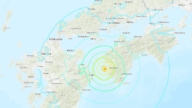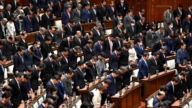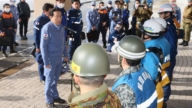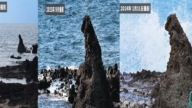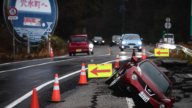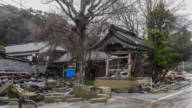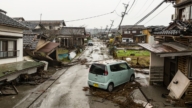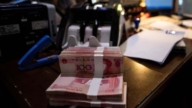【新唐人2011年3月16日訊】日本發生罕見的地震海嘯及核洩漏等共生災難。大陸網友對比中國和日本政府在災難中的反應,有不少新的發現。
日本面臨前所未有的浩劫,彷彿就像電影「明天過後」的場景,日本首相菅直人說,這是二戰以來日本面臨的最嚴重危機。
但這次災難,無論是日本政府或是民間反應,都令外界讚嘆不已。
我們回顧一下,地震發生當天3月11號,日本內閣政府正在開會。首相菅直人隨即中止會議,馬上設立了緊急災害對策本部。隨後,調遣 10萬全副武裝的自衛隊員前去救災,並開放各國救災隊伍投入工作。
時間倒回日本災變的前一天,3月10號,雲南盈江縣也發生了5.8級的地震,造成2萬多間房屋倒塌、受損,接近35萬人受災,有上萬人露宿街頭。
盈江縣居民袁先生:「我們這裡房子倒塌了好多,我們連帳篷都還沒有哎,哎呦,都住在露天底下,都站在路上,離去這裡的人多了,政府救災的工作一下子還到位不了。」
網友「龍捲風」回想起剛剛結束的兩會說,「我們沒有一次在兩會中提及我們的抗震問題。我們在兩會中大談民生,我們一次性可以死亡十萬人,這才是真正的民生大題。」
日本地震後,有大陸網友公布了一組對比照片。在日本地震現場,全副武裝的救援人員全都在專心的救助;而在中國的地震現場,身穿迷彩服的中國軍人們沒帶任何專業救災的裝備,大多數人並不是在救災,而是手舉各種橫幅和錦旗。
網友驚呼:「打旗的比救人的還多。這是領導要佈置工作嗎?是媒體要記錄這英明決策或是表態度、表決心、歷史瞬間嗎?是不是要等當官的做完秀。」
另一方面,日本災難的透明度同樣令大陸網友佩服。在這次日本災難中,日本官房長官每隔幾小時就開一次新聞發佈會,通報災情。日本各大媒體全天候的不斷滾動播出預警、災情和救援最新情況。外國記者可以不受限制的採訪。臉書和微博更成為重要通訊工具,日本消防廳專門開設了「災情微博」。
回到2008年中國汶川地震,中共當局禁止外國記者進入災區採訪報導,並限制國內媒體的報導內容。一切地震的災難都被報導成了黨和政府對人民的關愛。
民間維權人士譚作人更是因為調查汶川地震中的豆腐渣工程,而被當局以「煽動顛覆國家政權罪」判刑5年。
北京資深媒體人高瑜:「我聯想到汶川地震中死難的5000多名學生,還有為了調查這些學生,譚作人還被判了5年徒刑,艾未未組織調查團,艾未未還被打。所以我們這是人權災難,天災人禍,但是人家主要就是天災,這個差距是非常大的。」
逃離家園的日本災民被安排在學校裡臨時避難,這令億萬中國網友大跌眼鏡。因為2008年汶川地震中最揪心的一幕,就是大量「豆腐渣」工程的學校教室倒塌,壓死了正在上課的孩子們。
反觀日本,「抗震指標」是日本建築最重要的考量標準,日本《建築基準法》規定,建築物必需經得起6到7級的地震搖晃不會倒塌,商業大樓的標準更是定在能防震8級以上。
但是在中國,造成死人的真正原因卻是可悲的「豆腐渣」工程。中國民間《六四天網》負責人黃琦同樣因為在網上揭露豆腐渣,被中共判刑三年。
六四天網義工蒲飛:「盈江地震現在的很多救援方式和對房屋質量的看法,其實是符合最早譚作人先生,特別是黃琦先生,當時在災區向政府提出的一些建議,可是政府依然把他們關在監獄裡面,這是這個國家,這個民族的恥辱。」
旅美經濟學家何清漣在博客中寫道,就在三年以前四川汶川發生了地震,那場地震中天災與人禍糾結在一起,導致國人的創傷迄今還未平復。因此,中國人在這次日本地震中看到的更多。
新唐人記者趙心知、蕭宇綜合報導。
Learning from Sendai Earthquake
After major earthquake, tsunami,
and nuclear leakage took place in Japan,
Chinese netizens compare both governments
responses and made new discoveries.
The disaster in Japan was just like the scenes in
the film The Day After Tomorrow.
Japanese Prime Minister Naoto Kan said,
this is the biggest crisis in Japan since WWII.
The responses of the Japanese government
and people to the disaster
have tremendously amazed the world.
Let』s take a look back.
When the quake struck on March 11, PM Kan
immediately stopped his cabinet meeting,
set up an emergency rescue office,
dispatched 100,000 armed members
of the defense force to the disaster sites,
and invited international rescue squads to Japan.
One day before Japan』s earthquake, a 5.8-scale
quake struck Yingjiang County, Yunnan Province.
As a result, 20,000+ houses collapsed
or were damaged, with nearly 350,000 people
affected, and tens of thousands homeless.
Mr. Yuan, a local resident:
“Many of our houses collapsed,
and we do not have any tents yet.
We live in open air. Some are out on the street.
Many have left.
Government rescuers are not seen yet.”
Netizen “Tornado” recalled the late 『two meetings』
and said, “The 『two meetings』 never mentioned
about seismic issues, although they talked much
about people』s livelihood.
However, it is a real livelihood issue when
an earthquake claims tens of thousands of lives.”
Netizens posted photos for comparison.
On the Japanese quake sites,
fully equipped rescue workers were concentrated
on their rescuing efforts. While in the Chinese
quake sites, soldiers carried no professional
rescue equipments. Instead, most of them
were carrying various banners.
Netizens: “More banner holders than
rescue workers. Was this for the leaders to pose
for the media and glorify the CCP?
Or is it that the rescue can only begin
after the CCP leaders finish their poses?”
Japan』s press transparency also amazed
many Chinese. Japan』s Chief Cabinet Secretary
held press conferences every few hours
to update disaster relief. All major Japanese media
provide around the clock forecasts of after-quakes,
casualties and relief updates. Foreign reporters
can interview with no restrictions.
Facebook and microblogs have become
important communication tools.
The Japanese Fire Department
has even set up a “Disaster Microblog.”
Looking back at China』s Wenchuan earthquake
in 2008, the CCP』s regime prohibited
foreign reporters to enter disaster sites for interviews.
It even restricted foreign media reporting.
Disaster relief was reported as
CCP care for the people.
Chinese activist, Tan Zuoren, has been jailed
for 5 years for “inciting subversion of state power”
after he investigated whether shoddy construction
contributed to deaths of thousands of students
in the Wenchuan earthquake.
Chinese journalist, Gao Yu: “I remember
5000+ students died in the Wenchuan quake.
Tan Zuoren was sentenced to 5 years in prison
after he investigated the shoddy constructions.
Ai Weiwei was beaten for organizing
an investigation team. So we have
a human rights crisis, and a natural and man-made
disaster. But Japan only has a natural disaster.
It』s a big difference.”
The Japanese earthquake victims are sheltered
at schools. This surprises many Chinese netizens.
In the 2008 earthquake, many shoddy constructions
caused the collapse of school buildings and
killed many school children.
“The Guidelines for Earthquake Resistance” is
the most important guideline
for Japanese construction.
The “Building Standard Law” of Japan states,
the construction must be able to resist earthquakes
of magnitudes between 6 and 7.
Commercial buildings must be able to resist
earthquake magnitude of at least 8.
But in China, the cause of deaths is not
the earthquake, but the shoddy constructions.
Huang Qi, the founder of www.64tianwang.com,
was also sentenced to 3 years in prison for exposing
the shoddy constructions.
Pu Fei, a volunteer at www.64tianwang.com,
“During the Yingjiang earthquake,
the rescue method and construction inspection
followed advices given by Tan Zuoren
and Huang Qi. Yet both Tan and Huang
are still in jail for giving these advices.
That』s a shame. ”
Chinese economist, He Qinglian, said in her blog,
that Wenchuan earthquake happened 3 years ago.
It was both a natural and man-made disaster.
The wounds of Chinese people are still not healed.
That』s why Chinese people can learn so much
more from the Japanese earthquake.
NTD reporters Zhao Xinzhi and Xiao Yu


